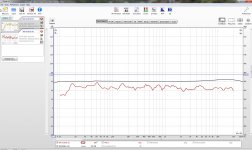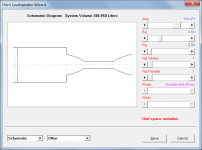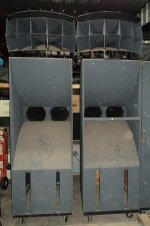So I repeat the question
Is that telling us that a simple vented box is simulated as a compound horn (CH)?
So I repeat the question
No, because it's not a simple vented box 🙂
So I repeat the second question
Is this the only way to sim a simple vented box?
The "usual" way would be like in the help file mentioned:Is that telling us that a simple vented box is simulated as a compound horn (CH)?
Is this the only way to sim a simple vented box?
Simple vented box is one that does not have the tapers added to the vent tube.
Of course you can do a backloaded horn and shape the horn like the vent.. This way you can do vents with different Shapes..Direct Radiator in a Vented-Box Enclosure
~~~~~~~~~~~~~~~~~~~~~~~~~~~~~~~~~~~~~~~~~
Select the 'Rear Vented' option from the Chamber tool and set S1 to L45 = 0
and Vrc, Lrc, Ap and Lpt > 0.
By default, only the direct radiator output is calculated. The Combined
Response tool can be used to determine the port output or the overall
direct radiator plus port output SPL response. An end correction is added
to the Lpt rear chamber port tube length where appropriate.
Thank you.The "usual" way would be like in the help file mentioned:
Of course you can do a backloaded horn and shape the horn like the vent.. This way you can do vents with different Shapes..
A simple vented box = a Direct Radiator in a Vented-Box Enclosure
And a double tapered vent can have some very interesting benefits when correctly applied.
I worked on this type of venting quite a bit. And never really found any significant benefit of using a damping material. No benefit in the low end. But in the damping materials range, it could make a difference in midband coverage.
I worked on this type of venting quite a bit. And never really found any significant benefit of using a damping material. No benefit in the low end. But in the damping materials range, it could make a difference in midband coverage.
Now I have a request.
Up till now I have always plotted a horn contour by good old hand drawing.
Is there any method to produce a drawing to scale using the data that Hornresp provides?
That would make my life so much easier. I t can take quite a while to plot a large horn flare.
Up till now I have always plotted a horn contour by good old hand drawing.
Is there any method to produce a drawing to scale using the data that Hornresp provides?
That would make my life so much easier. I t can take quite a while to plot a large horn flare.
So Excel is the answer.
I have tried this. And never end up with a graph that looks like a horn profile.
Please enlighten an Excel moron.
Second question is say that a correct horn profile can be generated as a graph. I know this is possible as I have seen them displayed by Master McBean.
How to take said graph and print it full scale to create a profile I can make a horn with?
I have a few drafting programs, all open source.
Sad to say where my limitations are, but don't ask, don't get!
I have tried this. And never end up with a graph that looks like a horn profile.
Please enlighten an Excel moron.
Second question is say that a correct horn profile can be generated as a graph. I know this is possible as I have seen them displayed by Master McBean.
How to take said graph and print it full scale to create a profile I can make a horn with?
I have a few drafting programs, all open source.
Sad to say where my limitations are, but don't ask, don't get!
I have measure the hornresp advised filling in the subwoofer box and get this outcome.
I think it looks very good, it have afcourse some room modes, I did post this also on bjorno place but have not answer yet.
Strange is that I have to put the isobaric subwoofer out of phase to get it right, when in fase I get a big fase error see last photo, I did see that the 24dB low pass do this, maybe the coils? who I made myselfs.
David, thanks for your answer about the fillings, it will be very nice if i can simulate with crossovers and the filling to get a complete picture.
regards
kees
I think it looks very good, it have afcourse some room modes, I did post this also on bjorno place but have not answer yet.
Strange is that I have to put the isobaric subwoofer out of phase to get it right, when in fase I get a big fase error see last photo, I did see that the 24dB low pass do this, maybe the coils? who I made myselfs.
David, thanks for your answer about the fillings, it will be very nice if i can simulate with crossovers and the filling to get a complete picture.
regards
kees
Attachments
I'll bet even David McBean did not know the journey he started.
Hi Andrew,
If I had known before I started how long the Hornresp journey would be, I doubt that I would have taken the first step 🙂.
Kind regards,
David
I was trying to sim the impact of stuffing in a vented alignment with a flared vent, as per diagrams below.
Hi Brian,
That is one weird-looking schematic diagram 🙂.
Kind regards,
David
I'm not sure this can be sim'd any other way in HornResp.
Hi Brian,
The design can also be modelled as a conventional 3-segment horn-loaded vented-box enclosure (albeit with a very large rear port tube cross-sectional area Ap). The combined response results should be identical to those generated by your compound horn model.
Kind regards,
David
Attachments
Last edited:
Have you been able to "sell" your expertise?...............If I had known before I started how long the Hornresp journey would be, I doubt that I would have taken the first step .............
Is that the parabolic expansion I can see in the not quite straight flanks of the flares?Ok, thanks. I was trying to sim the impact of stuffing in a vented alignment with a flared vent, as per diagrams below.
Post4173 also shows the "curves"
How could I have mistaken par for parallel?
Hi,
FYI:
b🙂
Impressive
Looks like the voice of the theatre? but mucho smaller.
Attachments
I am a bit puzzled about the system efficency plot. I did a simple vented Enclosure with a 15" PA Driver. When doing "multiple enclosures" with 2p2s, I get this:

From my understanding, efficency never can go beind 100%, or am I mising something?

From my understanding, efficency never can go beind 100%, or am I mising something?
Bjorno's sims in #4176 are almost the complete inverse of the Voice of the theatre, which uses a short front load horn, a huge back chamber and a port depth of 3/4" inch (the plywood thickness).Looks like the voice of the theatre? but mucho smaller.
- Home
- Loudspeakers
- Subwoofers
- Hornresp




